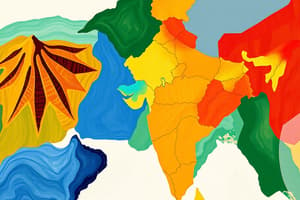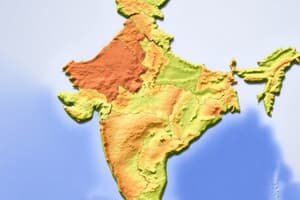Podcast
Questions and Answers
What are the major physical features of India?
What are the major physical features of India?
- Mountains, valleys, plateaus, deserts, and forests
- Mountains, valleys, rivers, plateaus, and islands
- Mountains, plains, deserts, plateaus, and islands (correct)
- Mountains, forests, rivers, plateaus, and islands
What type of land form can be found in the Peninsular Plateau?
What type of land form can be found in the Peninsular Plateau?
- Unstable zone with high peaks and deep valleys
- Alluvial deposits with deep valleys and fast flowing rivers
- Igneous and metamorphic rocks with gently rising hills and wide valleys (correct)
- Vast stretches of plain land with rugged terrain
What characterizes the physical features of the Himalayan mountains?
What characterizes the physical features of the Himalayan mountains?
- Gently rising hills and wide valleys
- Alluvial deposits and rugged terrain
- Unstable zone with ancient landmasses
- High peaks, deep valleys, and fast flowing rivers (correct)
Which region in India is formed of alluvial deposits?
Which region in India is formed of alluvial deposits?
What is the geological status of the Peninsular Plateau?
What is the geological status of the Peninsular Plateau?
Flashcards are hidden until you start studying
Study Notes
Physical Features of India
- India can be divided into three main physical regions: the Himalayan mountains, the Peninsular Plateau, and the Indo-Gangetic Plain.
Peninsular Plateau
- The Peninsular Plateau is a region of old, stable rocks that have been shaped by millions of years of weathering and erosion.
- It is a plateau region, characterized by a combination of hills, valleys, and plateaus.
Himalayan Mountains
- The Himalayan mountains are a young, folding mountain range, characterized by towering peaks, deep valleys, and steep slopes.
- They are still geologically active, with ongoing processes of folding, faulting, and volcanic activity.
Indo-Gangetic Plain
- The Indo-Gangetic Plain is a region of alluvial deposits, formed by the deposition of silt, sand, and other sediment by the rivers flowing from the Himalayas.
- This region is characterized by a flat, low-lying terrain with a network of rivers and their tributaries.
Geological Status of the Peninsular Plateau
- The Peninsular Plateau is a region of old, stable rocks that have been shaped by millions of years of weathering and erosion.
- It is geologically inactive, with no ongoing processes of folding, faulting, or volcanic activity.
Studying That Suits You
Use AI to generate personalized quizzes and flashcards to suit your learning preferences.




